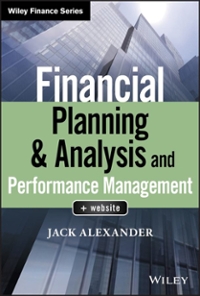This is the exercise with solutions. I only want help on Exc. 2D, draw with explanation by hand.

2. Asset Allocation (20Pts) Assume the world consists of 2 countries, B and S. B's market index has an expected return of 10% and a standard deviation of 16%. S's equity market has an expected return of 12% and a standard deviation of 20%. The returns of the two market exhibit a correlation of 0.6. The world risk-free rate is 3% and investors in both countries can borrow or lend at the world risk-free rate. a. Determine the composition of the optimal portfolio, and its Sharpe Ratio. (hint: the optimal weights of B and S are close to 75% and 25%. Correction: the optimal weights should be close to 50% each.) Answer: The optimal portfolio has weights wb = 52.8% and ws = 47.2% (see BKM and notes for all formula). The optimal portfolio expected return is 10.94% and its volatility is 16.01%. The SR is 0.496. b. If the countries expected returns satisfy the CAPM (i.e. the CAPM holds), what is the share of each country in the world market portfolio? Answer: If the CAPM holds, the tangency portfolio is the market portfolio. Therefore the weights of the country in the world market portfolio are equal to their weights in the optimal portfolio, wpikt = 52.8% and wMkt = 47.2%. c. If the CAPM holds and the representative investor has a utility function where utility is the expected return minus a penalty for volatility, where the penalty weight is the scaled coefficient of risk aversion, U(Rp) = E(Rp) 0.5Ao} what is the average risk aversion of the representative investor? Answer: If the CAPM holds, the representative investor holds the market portfolio, and w* the fraction of her wealth in the market portfolio is equal to 1. But E(Rp) -rf w* = => Ar= Aro? E(Rp) - rf w*o 0.1094 - 0.03 = 3.10 1 x 0.02562 d. Roy Safe is a conservative investor, with a risk aversion twice as high as the representative investor. Use a mean variance plot to show graphically what Roy's optimal portfolio volatility and return are in relation to the risk-free asset, the market portfolio of coun- try B and S, and the equity markets of B and S. Label the plot clearly and provide a short explanation of your answer. No computations are required. Answer: If Roy's risk aversion is twice as high as the representative investors risk aversion, his optimal share in the tangency portfolio will be half that of the representa- tive investor. Hence his overall portfolio will plot on the mid-point of the CML linking the risk free rate to the point representing the market portfolio (see BKM and notes). 2. Asset Allocation (20Pts) Assume the world consists of 2 countries, B and S. B's market index has an expected return of 10% and a standard deviation of 16%. S's equity market has an expected return of 12% and a standard deviation of 20%. The returns of the two market exhibit a correlation of 0.6. The world risk-free rate is 3% and investors in both countries can borrow or lend at the world risk-free rate. a. Determine the composition of the optimal portfolio, and its Sharpe Ratio. (hint: the optimal weights of B and S are close to 75% and 25%. Correction: the optimal weights should be close to 50% each.) Answer: The optimal portfolio has weights wb = 52.8% and ws = 47.2% (see BKM and notes for all formula). The optimal portfolio expected return is 10.94% and its volatility is 16.01%. The SR is 0.496. b. If the countries expected returns satisfy the CAPM (i.e. the CAPM holds), what is the share of each country in the world market portfolio? Answer: If the CAPM holds, the tangency portfolio is the market portfolio. Therefore the weights of the country in the world market portfolio are equal to their weights in the optimal portfolio, wpikt = 52.8% and wMkt = 47.2%. c. If the CAPM holds and the representative investor has a utility function where utility is the expected return minus a penalty for volatility, where the penalty weight is the scaled coefficient of risk aversion, U(Rp) = E(Rp) 0.5Ao} what is the average risk aversion of the representative investor? Answer: If the CAPM holds, the representative investor holds the market portfolio, and w* the fraction of her wealth in the market portfolio is equal to 1. But E(Rp) -rf w* = => Ar= Aro? E(Rp) - rf w*o 0.1094 - 0.03 = 3.10 1 x 0.02562 d. Roy Safe is a conservative investor, with a risk aversion twice as high as the representative investor. Use a mean variance plot to show graphically what Roy's optimal portfolio volatility and return are in relation to the risk-free asset, the market portfolio of coun- try B and S, and the equity markets of B and S. Label the plot clearly and provide a short explanation of your answer. No computations are required. Answer: If Roy's risk aversion is twice as high as the representative investors risk aversion, his optimal share in the tangency portfolio will be half that of the representa- tive investor. Hence his overall portfolio will plot on the mid-point of the CML linking the risk free rate to the point representing the market portfolio (see BKM and notes)







